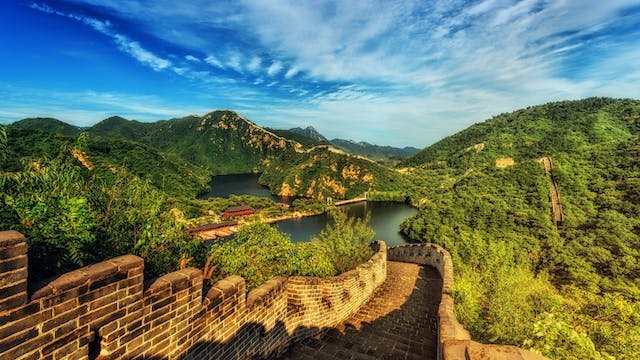China is a country with a rich history and culture that spans thousands of years. From its ancient dynasties to its modern cities, China has a wealth of landmarks and attractions that showcase its unique heritage. These landmarks not only serve as reminders of China’s past, but also as symbols of its cultural identity and national pride. Whether it’s the Great Wall of China, the Forbidden City, or the Terracotta Army, each landmark tells a story and offers a glimpse into China’s fascinating history.
Table of Contents
ToggleKey Takeaways
- The Great Wall of China is a remarkable feat of engineering and history.
- The Forbidden City is a stunning example of Chinese imperial architecture.
- The Terracotta Army is an impressive display of ancient Chinese military might.
- The Temple of Heaven is a peaceful sanctuary in the heart of bustling Beijing.
- The Summer Palace offers a serene escape from the city’s hustle and bustle.
The Great Wall of China: A Monumental Feat of Engineering and History
The Great Wall of China is perhaps one of the most iconic landmarks in the world. Stretching over 13,000 miles, it is a testament to the ingenuity and determination of the ancient Chinese people. The wall was built over several centuries, with construction beginning as early as the 7th century BC. Its primary purpose was to protect China from invasions by nomadic tribes from the north.
The construction of the Great Wall was an incredible engineering feat. It was built using a variety of materials, including stone, brick, wood, and earth. The wall was designed to be both defensive and symbolic, with watchtowers and fortresses strategically placed along its length. Today, visitors can explore different sections of the wall, each offering a unique perspective on this magnificent structure.
The Forbidden City: A Palace Complex that Defines Chinese Imperial Architecture
The Forbidden City is another landmark that showcases China’s imperial past. Located in the heart of Beijing, it served as the imperial palace for over 500 years during the Ming and Qing dynasties. The palace complex is an architectural masterpiece, with its intricate designs and grandeur.
The Forbidden City was designed to be both a residence for the emperor and his family, as well as the political center of the empire. It consists of over 900 buildings, with the Hall of Supreme Harmony being the most important. The palace complex is surrounded by high walls and a moat, symbolizing the emperor’s power and authority.
Today, the Forbidden City is open to the public and serves as a museum, showcasing the treasures and artifacts of China’s imperial past. Visitors can explore the various halls and courtyards, and get a glimpse into the lives of the emperors and their concubines.
The Terracotta Army: A Stunning Display of Ancient Chinese Military Might
The Terracotta Army is a remarkable archaeological discovery that highlights China’s military prowess during the Qin dynasty. Discovered in 1974 by local farmers, it consists of thousands of life-sized terracotta soldiers, horses, and chariots that were buried with Emperor Qin Shi Huang.
The Terracotta Army was created to accompany the emperor in the afterlife and protect him in his journey. Each soldier is unique, with different facial expressions and hairstyles. The army is arranged in battle formation, with infantry, cavalry, and archers.
Visiting the Terracotta Army today is a truly awe-inspiring experience. The site has been turned into a museum, where visitors can see the soldiers up close and learn about their history and significance. It is a testament to China’s ancient civilization and military might.
The Temple of Heaven: A Spiritual Haven in the Heart of Beijing
The Temple of Heaven is a sacred site that has been an important place of worship for centuries. Located in Beijing, it was built during the Ming dynasty and served as a place for emperors to pray for good harvests and divine guidance.
The architecture of the Temple of Heaven is stunning, with its intricate designs and vibrant colors. The main hall, known as the Hall of Prayer for Good Harvests, is a circular building with a triple-eaved roof. It is surrounded by beautiful gardens and pavilions, creating a serene and peaceful atmosphere.
Today, the Temple of Heaven is open to the public and serves as a park where locals and tourists can relax and enjoy the beautiful surroundings. It is a place of cultural significance and spiritual importance, reflecting China’s deep-rooted traditions and beliefs.
The Summer Palace: A Serene Escape from the Bustle of City Life
The Summer Palace is a magnificent imperial garden that served as a retreat for emperors during the hot summer months. Located in Beijing, it is a UNESCO World Heritage site and one of China’s most popular tourist attractions.
The history of the Summer Palace dates back to the 12th century, but it was during the Qing dynasty that it was expanded and transformed into its current form. The palace complex is centered around Kunming Lake, with beautiful pavilions, temples, and bridges scattered throughout the gardens.
Visiting the Summer Palace today offers a glimpse into the opulent lifestyle of China’s emperors. Visitors can take a boat ride on Kunming Lake, explore the various halls and pavilions, and enjoy the tranquility of the gardens. It is a place of natural beauty and cultural significance, providing a peaceful escape from the hustle and bustle of city life.
The Yellow Mountains: A Natural Wonder of China’s Scenic Beauty
The Yellow Mountains, also known as Huangshan, are a range of mountains in eastern China that are renowned for their stunning natural beauty. They have been an inspiration for countless artists and poets throughout history.
The history of the Yellow Mountains dates back thousands of years, with its peaks and valleys shaped by volcanic activity. The mountains are known for their unique granite peaks, hot springs, and ancient pine trees. The scenery is ever-changing, with misty clouds often enveloping the peaks, creating a mystical atmosphere.
Visiting the Yellow Mountains today offers an opportunity to immerse oneself in nature and experience the awe-inspiring beauty of the landscape. There are numerous hiking trails and cable cars that allow visitors to explore the mountains and take in the breathtaking views. It is a place of natural wonder and a testament to China’s diverse and stunning scenery.
The Potala Palace: A Majestic Tibetan Icon in the Heart of Lhasa
The Potala Palace is a majestic landmark that is synonymous with Tibet. Located in Lhasa, it is the highest palace in the world and a UNESCO World Heritage site. The palace was originally built in the 7th century, but it was during the reign of the 5th Dalai Lama that it was expanded and transformed into its current form.
The architecture of the Potala Palace is awe-inspiring, with its white walls, golden roofs, and intricate designs. It consists of over 1,000 rooms, including chapels, libraries, and living quarters for the Dalai Lama. The palace is a symbol of Tibetan Buddhism and serves as a spiritual center for Tibetans.
Visiting the Potala Palace today offers a glimpse into Tibet’s rich cultural heritage and religious traditions. Visitors can explore the various halls and chapels, admire the stunning views of Lhasa from the rooftop, and learn about Tibetan Buddhism. It is a place of immense beauty and spiritual significance.
The Giant Panda Breeding Research Base: A Conservation Effort for China’s Most Beloved Animal
The giant panda is one of China’s most beloved animals and a symbol of conservation efforts worldwide. The Giant Panda Breeding Research Base in Chengdu is dedicated to protecting and breeding these endangered animals.
The history of giant panda conservation dates back to the 1960s when their population was on the brink of extinction. The research base was established in 1987 with the goal of increasing the panda population through captive breeding and reintroduction programs.
Today, the research base is home to over 100 pandas, making it one of the largest panda breeding centers in the world. Visitors can observe the pandas in their natural habitat, learn about their behavior and conservation efforts, and even participate in volunteer programs. It is a place of hope and a reminder of the importance of protecting endangered species.
The Three Gorges Dam: A Controversial Hydroelectric Power Plant with a Massive Impact
The Three Gorges Dam is a massive hydroelectric power plant that spans the Yangtze River in central China. It is one of the largest and most controversial engineering projects in history.
The history of the Three Gorges Dam dates back to the 20th century when plans were first proposed to harness the power of the Yangtze River. Construction began in 1994 and was completed in 2006. The dam has had a significant impact on the environment and local communities, with millions of people being displaced and ecosystems being disrupted.
Visiting the Three Gorges Dam today offers an opportunity to witness the scale and impact of this engineering marvel. Visitors can take boat tours along the Yangtze River, learn about the dam’s construction and operation, and see firsthand the environmental and social changes that have occurred as a result.
The Zhangjiajie National Forest Park: A Landscape that Inspired the “Avatar” Movie’s Scenery
The Zhangjiajie National Forest Park is a stunning landscape that served as inspiration for the scenery in James Cameron’s movie “Avatar.” Located in Hunan province, it is known for its towering sandstone pillars, deep canyons, and lush vegetation.
The history of Zhangjiajie dates back millions of years when these unique rock formations were shaped by erosion and weathering. The park is home to numerous hiking trails, glass bridges, and cable cars that allow visitors to explore its natural beauty.
Visiting Zhangjiajie National Forest Park today offers a chance to immerse oneself in a surreal and otherworldly landscape. The park is a UNESCO World Heritage site and attracts millions of visitors each year. It is a place of natural wonder and a testament to the beauty and diversity of China’s landscapes.
China’s landmarks and attractions are not only important for their historical and cultural significance, but also for their ability to inspire and captivate visitors from around the world. From the Great Wall of China to the Zhangjiajie National Forest Park, each landmark tells a story and offers a unique perspective on China’s rich history and culture.
Preserving and appreciating these landmarks is crucial for future generations to understand and appreciate China’s heritage. They serve as reminders of the past and symbols of national pride. Whether it’s through conservation efforts, tourism, or education, it is important to ensure that these landmarks continue to be protected and celebrated for years to come.
Contact our head teacher, Chen Huimin, at info@lcchineseschool.com if you want to learn Chinese or have additional questions about our Chinese programs.
Sign up for a free trial class here.
Learn about our Internship Program in China.
Get free Chinese learning resources.
Learn about China’s 2024 Offical Holiday Schedule








